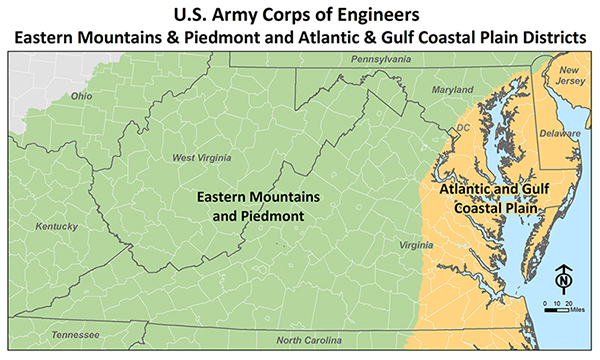
|
| Vol. 22, No. 5 |
September 30, 2014 |
|
|
Change in Indicator Status of Japanese Honeysuckle
|
In 2012 the US Army Corps of Engineers (COE) published a new National Wetland Plant List (2012 NWPL), superseding the 1988 NWPL previously published by the US Fish and Wildlife Service (WSSI’s NWPL article from May 31, 2012). One of the most significant changes to the 2012 NWPL for our region included the change in indicator status of Japanese honeysuckle (Lonicera japonica) from Facultative-minus (FAC-) to Facultative (FAC) in the Eastern Mountains and Piedmont (EMP) Region and in the Atlantic and Gulf Coastal Plain (AGCP) Region (a switch from being considered a non-wetland plant to a wetland plant). Since Japanese honeysuckle is a very common plant found in a variety of habitats and plant communities in our region (the plant is especially prevalent along the transition zone of wetland to upland habitats), the change in indicator status from FAC- to FAC had the potential to result in a positive dominance test for hydrophytic (i.e., wetland) vegetation when this plant occurred as a dominant species and potentially expand the wetland boundary. |
 |
Japanese honeysuckle (Lonicera japonica)
(original image from nps.org)
|
|
| |
 |
| The NWPL is updated periodically, reflecting changes in nomenclature and plant indicator statuses with the publishing of new editions on a (so-far) yearly basis. This update process includes public comments to help make decisions that would reflect a larger base of knowledge and experience compared to the 1980’s. One of the changes that occurred in the 2014 NWPL is the change in indicator status of Japanese honeysuckle in the AGCP Region from FAC to Facultative-Upland (FACU) (a non-wetland designation). However, the indicator status of this plant was kept as FAC in the EMP Region. |
| |
| On March 31, 2014, the National Association of Home Builders (NAHB) submitted a challenge requesting to have the indicator status for Japanese honeysuckle in the EMP Region changed from FAC to FACU. On May 22, 2014 the COE responded to the challenge request via the release of a document on their website: http://rsgisias.crrel.usace.army.mil/NWPL/ (under the “Whats New” tab in the top left corner), which lists Japanese honeysuckle as FACU for the EMP Region, effective immediately (a switch from being considered a wetland plant to a non-wetland plant). The change will be reflected on the next published version of the NWPL in 2015. In the interim, although the rating for Japanese honeysuckle is still listed as FAC for the EMP Region on the current 2014 NWPL posted on the COE’s website (including the search function on the website) and on the USDA Plants website, the indicator status for Japanese honeysuckle is now FACU in the EMP Region. |
| |
| These changes to the NWPL are published on the COE’s website; however, there is no formal public notification process that announces when revisions have occurred. Until such a process is established, WSSI is routinely checking the COE’s website for unannounced changes to the NWPL for our region. Any significant changes (such as the change in indicator status of Japanese honeysuckle for the AGCP and EMP Regions) will be presented in our newsletter. For the most up-to-date NWPL for the EMP Region and the AGCP Region, please visit our website (at the top of our wetland delineation page, select the AGCP or EMP list). |
|
|
|
|
 |
|
|